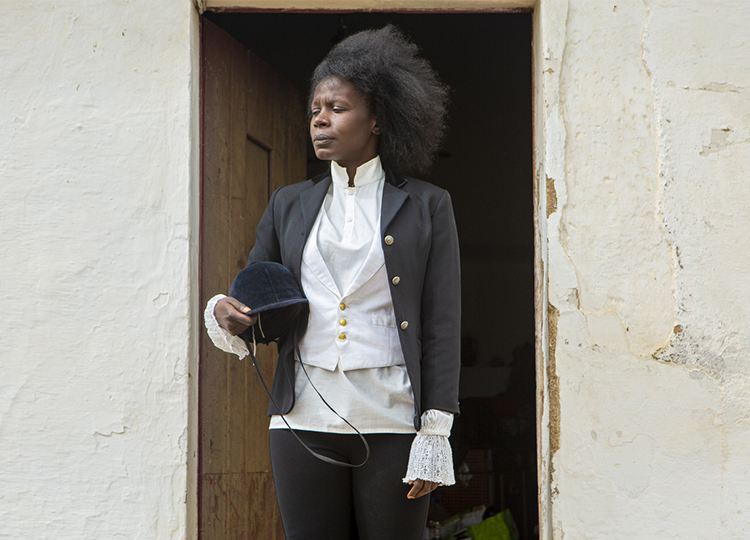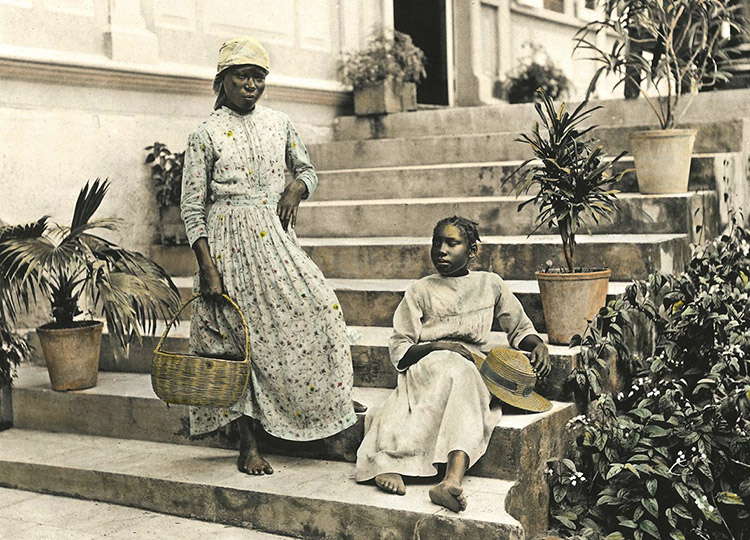For over 30 years Autograph has worked with artists, collecting and commissioning images with a unique focus on black experiences and the politics of representation. Here, using the artistic work of Rotimi Fani-Kayode as a case study, Autograph’s director, Professor Mark Sealy, traces the complex journeys and conversations involved in our advocacy work.
This text was created for Autograph’s commissioning project Amplify – Stranger in the Village: Afro European Matters, considering contemporary Afrodiasporic experiences in Europe and supporting artistic practices which address the representation of black artists in UK collections.
FotoFest Houston, Texas in March 1992 is a breakthrough moment in recognising the photographic works that Rotimi Fani-Kayode produced. Just over two years after his tragic and untimely death in December 1989, his beautiful, transgressive, and seductive colour works were displayed publicly for the first time at an international photographic festival.
The exhibition was titled "Inside Out" Black British Photography and included works by Claudette Holmes, David A. Bailey, and Ingrid Pollard amongst others. This critical and often overlooked exhibition was shown across two distinctly different Houston sites. The main galleries at the George R. Brown Convention Centre (located on the east side of Downtown Houston) and a community arts space, Barnes-Blackman Galleries, founded by artist and activist Michelle Barnes (located in Houston's tough Third Ward). The UK curatorial overview for both projects was led by Derek Bishton from the Birmingham-based Ten.8 magazine.
At the Convention Centre, Fani-Kayode's photographs were shown next to the works of the Brazilian photographer Mário Cravo Neto. Cravo Neto's work, like Fani-Kayode's, was influenced by a deep immersion and knowledge of Yoruba culture. The dialogue that was set up between these two artists created a stunning visual drama that explored questions of sexuality, desire, and identity. Both these artists' exquisitely seductive works were produced in what could be described retrospectively as a culturally fluid and diasporic Yoruba cosmology. Curators from museums and galleries worldwide were intrigued, perplexed, and moved by the synergy generated between these artists' works. For those present, the dialogue between these works created an opportunity to rethink and delink from photography's dominant Eurocentric traditions. What became evident from the experience of being in Houston during this period was that the traditional history of photography was dominated by a narrow Eurocentric canon. Houston 1992 was where some of the missing chapters of photography, its unheard voices, and cultural ghosts had a dynamic sense of presence.
Mark Hayward-Booth, then Senior Curator of Photography at the Victoria and Albert Museum, also attended FotoFest that year. During our time in Houston, we discussed the impact of Fani-Kayode's photographs and how important it was that works from outside Europe and North America were being brought into focus through such events. The central theme for FotoFest that year was Latin America but seeing Fani-Kayode's photographs within this context pulled his work towards a reading that resonated with Other artists engaged with indigenous cultures and knowledge formations from the global south. Fani-Kayode's practice within this atmosphere felt more locatable, magical, vibrant, relevant, and alive.
Okwui Enwezor arrived in London in early 1995. He was on a research trip for a photography exhibition scheduled for late 1996 at the Solomon R. Guggenheim Museum in New York. It was titled In/sight: African Photographers, 1940 to the Present. After sharing with Enwezor, a rough copy of the forthcoming monograph that I was co-editing with Revue Noire on Fani-Kayode's work, Enwezor confirmed that Fani-Kayode's works would be an exciting addition to the exhibition. Six colour photographs at approximately 24 x 24 inches were produced as Cibachrome prints for the forthcoming show. These works occupied a unique space within the exhibition; one that addressed Fani-Kayode’s complex identity formations. As images, his works pushed against the grain of African and queer representational politics. The articulation of Fani-Kayode's sense of being an outsider was now fully evident within the context of a significant African photography exhibition.
Some 20 years later, I spent a few days with Jennifer Blessing, Senior Curator of Photography at the Solomon R. Guggenheim Museum. We were both judging the Hasselblad Award in Sweden. During dinner, I shared the story behind Enwezor's visit and that the prints from the In/sight exhibition were still held at Autograph and stored in the original crate that Guggenheim had made to return them in. After this discussion, Jennifer began a process of acquisition for the six prints, and in 2017, the works were acquired, and they journeyed back to the Guggenheim.
In 1996 Hayward-Booth contacted the Autograph office to enquire about acquiring a print for the Victoria and Albert Museum’s print collection. The book Rotimi Fani-Kayode & Alex Hirst: Photographs published by Autograph in partnership with Revue Noire had just been released. The work that Hayward-Booth was interested in was titled Nothing to Lose XII, 1989. It portrays a side view of a black male nude figure in a crunch (sit up) position; fruits cover his genitals. We can see that a glistening liquid flows down the side of his thigh and hip, adding an erotic charge. Hayward-Booth and I discussed the work, and we agreed that a small print around 12 x 10 inches, thought to have been made by the artist in 1989, would be an excellent addition to the collection. This moment marked a very significant milestone for Fani-Kayode. It was the artist's first museum acquisition. What pleased me most concerning this acquisition was that his radical imagery was now bound to this important photographic collection forever. It also meant that the promise I made to Fani-Kayode's lover and collaborator Alex Hirst - to work to keep Fani-Kayde's legacy alive - now had a firmer foundation.
Diversifying the holdings of museums and developing our own collection has been a core concern for Autograph. This work has been done through a determined effort to identify and fill some critical gaps across photography's history.
Autograph can now take pride in the pioneering research, exhibition, publishing, and commissioning work developed within the organisation since its foundation in 1988. For example, the Autoportraits exhibition held at Camerawork, London, in 1990 set a curatorial modus operandi for Autograph. Through agency, advocacy, and acquisition, we can now arc back, reflect on time and celebrate the unique role the organisation continues to play across the arts, especially in keeping black photographic practice visible and accessible across and in curatorial cultures worldwide.
Some cultural institutions we have worked directly and indirectly with in recent years include The Iziko South African National Gallery, The Art Gallery of Ontario, the Solomon R. Guggenheim Museum, The Wedge Collection, Walther Collection and the National Portrait Gallery London. In addition, Tate has acquired works by Rotimi Fani-Kayode, John Akomfrah, Maud Sulter, Ajamu and Faisal Abdu' Allah amongst others who Autograph have championed. Notably, and through a generous donation made by Eric and Louise Franck in 2012, Tate now hold key works by many black photographers. These include Horace Ove, Armet Francis, Eileen Perrier, Neil Kenlock, James Barnor, and Bandele 'Tex' Ajetunmobi, to name but a few.
The Francks worked directly with Autograph over several years to establish a more diverse range of photographers to include in their collection, focusing on London in photographs. Eric Franck visited our offices over many years. Renée Mussai, our Senior Curator, took Eric Franck on an exciting journey through key black artists' works. Many of these works at the time of writing are currently on display at Tate Britain.
Our collection, developed in dialogue with artists over 30 years, is grounded in a culture of caring and sharing images and histories produced by and about the black presences in photographic history. Autograph continues to work with major museums such as Brighton Museum and Art Gallery, Gallery Oldham and the Victoria and Albert Museum, which, through their Staying Power initiative assisted and facilitated the acquisition of works by Maxine Walker, Raphael Albert, James Barnor, Syd Shelton, Dennis Morris, Colin Jones, and many others. In addition, as part of core work programmes, we continue to advocate, research, commission, and increasingly loan photographs from our unique and growing photographic collection.

Autograph's commissioning project considering contemporary Afrodiasporic experiences in Europe, supported by the Art Fund.
Read more
Supporting artists is essential to us at Autograph. We’ve been commissioning the making of new work since 1989, inviting creative practitioners to explore ideas of representation, identity, rights and social justice.
See moreCan you spare a few moments? Autograph is carrying out a survey to better understand who our digital audiences are. The survey should take no longer than five minutes to complete. Anything you tell us will be kept confidential, is anonymous and will only be used for research purposes.
The information you provide will be held by Autograph and The Audience Agency, who are running the survey on our behalf. In compliance with GDPR, your data will be stored securely and will only be used for the purposes it was given.
You can take the survey here. Thank you!
Banner image: Rotimi Fani Kayode, Tulip Boy [detail], 1989. Courtesy of Autograph, London.
Images on page: 1) Rotimi Fani-Kayode, Adebiyi, ca. 1989. Courtesy of Autograph, London. 2) Rotimi Fani-Kayode, Every Moment Counts (Ecstatic Antibodies), ca. 1989. Courtesy of Autograph, London. 3) Rotimi Fani-Kayode, Nothing to Lose XII (Bodies of Experience), ca. 1989. Courtesy of Autograph, London. 4-5) Installation view: Implicit Tensions: Mapplethorpe Now (Part 2), July 24, 2019–January 5, 2020, Solomon R. Guggenheim Museum, New York. Photograph by David Heald © Solomon R. Guggenheim Foundation, New York.
Other images on page: 6) Mónica de Miranda, Dressage [detail], from The Island. © the artist. Courtesy of / commissioned by Autograph, 2021. Supported by Art Fund. 7) Ingrid Pollard, The Valentine Days. © the artist. Courtesy of / commissioned by Autograph, 2017.

Autograph is a place to see things differently. Since 1988, we have championed photography that explores issues of race, identity, representation, human rights and social justice, sharing how photographs reflect lived experiences and shape our understanding of ourselves and others.